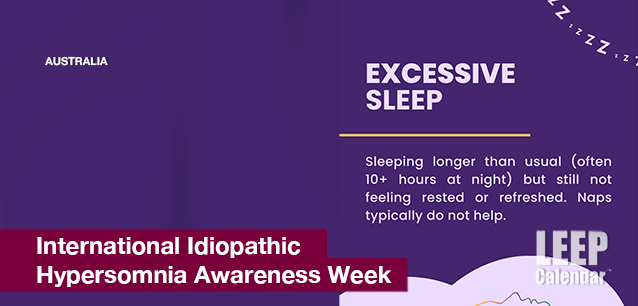 AD
AD
Today is: November 19
Scroll to explore events active on this date.
LEEP INK FEATURES

August? Absolutely!
In August, we live through the Dog Days of Summer. It's hot and often humid, and those who can leave for better climates do. Down south, winter is in full force. August is also known as "the ...

In The Heat of July: July 2025 Events
Is it hot enough (or cold enough if you're below the equator) for you yet? There is actually a day for that! Like every month, I pick a diverse collection of events you may or may not know about. This ...

May Blooms: Events in May 2025
Along with October, May is one of the most densely packed months of the year. It's before the summer humidity and the last whole month of the school year. The weather is warming in t...
About International Idiopathic Hypersomnia Awareness Week
Australia
Ends: Jun 07, 2025
DESCRIPTION:
INTERNATIONAL IDOPATHIC HYPERSOMNIA AWARENESS WEEK®
FOCUSING ON A RARE SLEEP DISORDER
Idiopathic Hypersomnia Awareness Week (IHAW) is a global campaign designed to increase awareness of Idiopathic Hypersomnia.
Idiopathic Hypersomnia is a sleep disorder in which the person afflicted feels chronically sleepy during the day and has difficulty waking. Idiopathic Hypersomnia is the less-known cousin of narcolepsy, a rare and chronic neurological sleep disorder that leaves those who suffer from it feeling perpetually exhausted—no matter how much they sleep.
The term "idiopathic" means "of unknown cause," in this case, it underscores how much the disorder remains a mystery. Patients with idiopathic hypersomnia (IH) experience excessive daytime sleepiness that isn't relieved by naps or extended nighttime rest. Some may sleep more than 10 hours a night and still struggle to remain awake during the day. Others may find waking up challenging, often needing several alarms or even physical help to rise, a symptom known as "sleep inertia."
Unlike sleep deprivation or conditions such as sleep apnea, IH does not result from poor sleep habits or interruptions during the night. The cause is unknown, though researchers suspect an abnormality in the brain impacting the sleep-wake cycles. Another theory examines the central nervous system's response to GABA, a neurotransmitter that induces sleepiness.
There is no known trigger, and the disorder can appear without warning—often in adolescence or young adulthood. It affects both men and women.
Living with IH can be profoundly isolating. Many patients report difficulties in maintaining employment, education, or social relationships. The constant sleepiness can impair memory, focus, and reaction time, making daily tasks daunting. Patients often describe it as "like walking through life in a fog."
Treatment remains a challenge. Because the underlying cause is unknown, there is no cure—only symptom management. Doctors often prescribe wake-promoting medications like modafinil or amphetamines, with varying success. For some, these drugs provide temporary relief; for others, they do little to combat the relentless fatigue.
VIDEOS
SUPPORTING DOCUMENTS
Currently, this event does not have supporting documents.
ADDITIONAL IMAGES
Currently, this event does not have supporting images.
Where would you like to go now?
 AD
AD


/footer-logo.svg)
